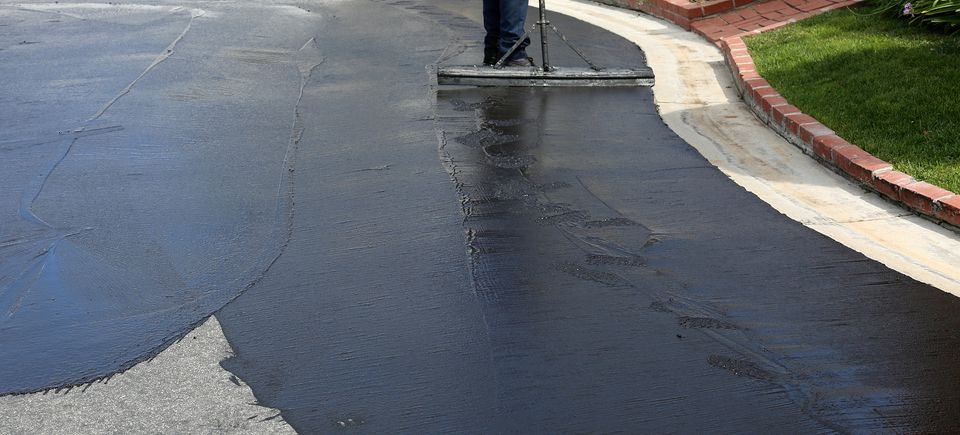Change Your Building's Aesthetics: Commercial Parking Lot Leading and Asphalt Sealing Solutions
Warm Mix Asphalt: A Sustainable Option for Sidewalk
Hot Mix Asphalt (HMA) has become a leading sustainable option for sidewalk options, using a myriad of ecological advantages and cutting-edge modern technologies. Its capacity to decrease and reuse products energy intake provides a compelling instance for its adoption in road construction jobs. The long-term efficiency and durability of HMA make it a recommended alternative for framework growth. As the demand for environment-friendly building practices grows, discovering the subtleties of HMA's sustainability can give useful understandings right into the future of pavement options.
Ecological Advantages of Warm Mix Asphalt

In Addition, Warm Mix Asphalt helps to alleviate city warm island results. Its dark color takes in sunlight, minimizing the amount of warm mirrored back into the ambience contrasted to lighter-colored sidewalks. This can reduce ambient temperatures in city locations, lowering the need for air conditioning and ultimately minimizing power intake.
Additionally, Warm Mix Asphalt adds to boosted stormwater administration. Its permeable nature enables water to charge and infiltrate the pavement groundwater supplies, decreasing overflow and the danger of flooding. These ecological advantages make Hot Mix Asphalt a sustainable selection for leading roads and highways.
Energy Performance in HMA Manufacturing
Is energy performance an important aspect in the production of Warm Mix Asphalt (HMA)? Power plays a considerable role in the manufacturing of HMA, affecting both price and ecological sustainability. One key element of energy performance in HMA manufacturing is the usage of cozy mix asphalt (WMA) modern technologies.
Additionally, innovations in plant modern technologies have led to more energy-efficient HMA manufacturing processes. Modern plants are created with features like recycled asphalt pavement (RAP) processing capacities, efficient burner systems, and enhanced insulation, all contributing to energy savings. By maximizing energy use in HMA manufacturing, the market can lower its carbon impact while keeping premium sidewalk materials. Energy effectiveness is, for that reason, an essential consideration in making certain the sustainability of Hot Mix Asphalt production.
Recyclability of Warm Mix Asphalt
The recyclability of Hot Mix Asphalt (HMA) is a crucial facet of its sustainability and long-term environmental impact. HMA is one of the most recycled materials in the USA, with over discover this info here 100 million lots of reclaimed asphalt sidewalk (RAP) being recycled every year in brand-new pavement construction. Reusing HMA uses numerous environmental benefits, such as reducing the demand for virgin products, lowering power consumption during production, and reducing the quantity of waste sent out to land fills.
The procedure of reusing HMA includes grating the existing pavement, squashing it into smaller items, and blending it with brand-new aggregate and asphalt binder to produce a recycled mix. This recycled mix can typically carry out as well as and even much better than traditional HMA, while needing fewer resources and creating reduced greenhouse gas emissions. By including RAP into brand-new pavement tasks, roadway companies can preserve natural deposits, minimize costs, and minimize the ecological impact of roadway building and construction and maintenance tasks. Generally, the recyclability of HMA plays a substantial function in promoting sustainable practices within the sidewalk market.

Long-Term Performance of HMA
Asphalt pavements demonstrate resilience and strength over an extensive period, mirroring the lasting efficiency of Hot Mix Asphalt (HMA) Furthermore, developments in HMA modern technology, such as the use of polymer-modified binders and warm mix asphalt, have actually further enhanced the sturdiness and long life of HMA pavements. By prioritizing quality construction and maintenance techniques, HMA continues to prove itself as a lasting and cost-efficient service for lasting pavement facilities.

HMA: Toughness and Sustainability
Demonstrating both resilience and sustainability, Hot Mix Asphalt (HMA) has become a foundation in the building and construction of lasting sidewalk frameworks - regrading. HMA's longevity stems from its capacity to stand up to hefty tons, extreme weather condition conditions, and high traffic quantities, making it a dependable option for roadways, freeways, and flight terminal paths. The structure of HMA, which usually consists of aggregates, binder, and filler, plays a critical function in enhancing its long life and resistance to tear and use
Furthermore, HMA's sustainability hinges on its recyclability and energy-efficient manufacturing process. The capability to recycle reclaimed asphalt pavement (RAP) in brand-new HMA mixtures minimizes the need for virgin materials and lessens the ecological effect of pavement building and maintenance. Additionally, the energy effectiveness of generating HMA hinges on its lower blending find out this here temperatures compared to other sidewalk products, leading to reduced energy consumption and greenhouse gas discharges.
Final Thought
To conclude, hot mix asphalt (HMA) provides a lasting option for pavement with its environmentally friendly features. HMA's recyclability, power efficiency in manufacturing, and long-lasting longevity make it an environment-friendly option for roadway building. By conserving natural deposits, minimizing waste, and reducing greenhouse gas emissions, HMA plays an important duty in promoting sustainability in framework growth. Its his response capacity to alleviate urban heat island impacts additionally highlights its importance in producing ecologically conscious and resilient pavement systems.
HMA is one of the most recycled products in the United States, with over 100 million lots of redeemed asphalt sidewalk (RAP) being recycled each year in brand-new sidewalk building and construction.The procedure of recycling HMA entails crushing the existing sidewalk, squashing it into smaller sized items, and blending it with brand-new aggregate and asphalt binder to produce a recycled mix.Asphalt sidewalks demonstrate longevity and resilience over an extensive duration, showing the long-lasting performance of Warm Mix Asphalt (HMA) In addition, advancements in HMA technology, such as the usage of polymer-modified binders and cozy mix asphalt, have actually even more improved the toughness and longevity of HMA sidewalks. The ability to reuse reclaimed asphalt pavement (RAP) in new HMA blends reduces the need for virgin materials and minimizes the environmental impact of sidewalk building and maintenance.